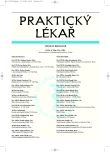Estimates of absolute cardiovascular risk in the Czech Republic
Authors:
J. Reissigová 1
; J. Zvárová 1,2
Authors‘ workplace:
Evropské centrum pro medicínskou informatiku, statistiku a epidemiologii
Ředitelka: prof. RNDr. Jana Zvárová, DrSc.
; Oddělení medicínské informatiky, Ústav informatiky AV ČR v. v. i., Praha
1; Univerzita Karlova v Praze, 1. LF a VFN
Ústav hygieny a epidemiologie
Přednosta: prof. MUDr. Vladimír Bencko, DrSc.
2
Published in:
Prakt. Lék. 2008; 88(5): 288-292
Category:
Of different specialties
Overview
Aim:
The aim was to validate estimates of absolute ten-year cardiovascular risk in men from the Czech Republic:
a) the risk of coronary heart diseases (CHD) estimated by the Framingham risk function (1998), and
b) the risk of fatal cardiovascular disease estimated by the SCORE nomogram (2005).
Material and Methods:
The estimates were validated within the longitudinal primary prevention study of atherosclerotic risk factors (STULONG). Calibration and discrimination accuracies of the estimates were evaluated by the Hosmer-Lemeshow test and ROC curve, respectively.
Results:
The 10-year risk of CHD was estimated according to the Framingham risk function (1998) for each man (n=646). Men were categorized into five groups defined by quintiles of the estimated risk. The estimated ten-year risk was lower than that observed in all five groups (p=0.013). Discrimination accuracy of the Framingham risk function was 63.8 %, 95% CI (58.4 %, 69.1 %). The SCORE nomogram was validated in 1025 men. The largest difference between the estimated and observed risk was in the groups at the highest estimated risk. Totally, no significant difference between the estimated and observed risk was found at 5% significance level (p=0.068). Discrimination accuracy of the SCORE nomogram was 75.0 %, 95% CI (66.4 %, 83.6 %).
Conclusion:
The Framingham risk function (1998) significantly underestimated the risk of CHD in men from the study STULONG. The SCORE nomogram (2005) estimated the risk of fatal cardiovascular risk better - excluding men at high-risk. Discrimination accuracy of the SCORE nomogram (2005) was somewhat better than that of the Framingham risk function (1998).
Key words:
Framingham heart study, SCORE study, estimate of cardiovascular risk, validation study.
Sources
1. Anderson. K.M., Wilson, P.W., Odell, P.M., Kannel, W.B. An updated coronary risk profile. A statement for health professionals. Circulation 1991, 83, 1, p. 356-362.
2. Anderson, K.M., Odell, P.M., Wilson, P.W., Kannel, W.B. Cardiovascular disease risk profile. Am. Heart. J. 1991, 121 (1 Pt 2), p. 293-298.
3. Bencko, V., Hrach, K., Malý, M. a kol. Statistické metody v epidemiologii. In: J. Zvárová, M. Malý (editoři): Biomedicínská statistika III. Praha: Univerzita Karlova, Nakladatelsví Karolinum, 2003.
4. Boudík, F., Reissigová, J., Hrach, K. et al. Primary prevention of coronary artery disease among middle aged men in Prague: twenty-year follow-up results. Atherosclerosis 2006, 184, 1, p. 86-93.
6. Conroy, R.M., Pyorala, K., Fitzgerald. A.P. et al. SCORE project group. Estimation of ten-year risk of fatal cardiovascular disease in Europe: the SCORE project. Eur. Heart. J. 2003, 24, 11, p. 987-1003.
7. D’Agostino, R.B., Russell, M.W., Huse, D.M. et al. Primary and subsequent coronary risk appraisal: New results from the Framingham study. Am. Heart J. 2000, 139 (2 Pt 1), p. 272-281.
8. D’Agostino, R.B., Grundy, S., Sullivan, L.M., Wilson, P. Validation of the Framingham coronary heart disease prediction scores: results of a multiple ethnic groups investigation. JAMA, 2001, 286, 2, p. 180-187.
9. D’Agostino, R.B., Nam, B-H. Evaluation of the performance of survival analysis models: discrimination and calibration measures. In: Balakrishnan N and Rao CR (editors): Handbook of Statistics Volume 23: Advances in Survival Analysis. Amsterdam: Elsevier 2004.
10. Eng, J. ROC analysis: web-based calculator for ROC curves [online]. Baltimore: Johns Hopkins University [updated 2007 Sep 11]. Dostupný na www.jrocfit.org.
11. Petersen, S., Peto, V., Rayner, M. et al. European Cardiovascular Disease Statistics. London: British Heart Foundation, 2005.
12. Neuhauser, H.K., Ellert, U., Kurth, B.M. A comparison of Framingham and SCORE-based cardiovascular risk estimates in participants of the German National Health Interview and Examination Survey 1998. Eur. Cardiovasc. Prev. Rehabil. 2005, 12, 5, p. 442-450.
13. Pencina, M.J., D’Agostino, R.B. Overall C as a measure of discrimination in survival analysis: model specific population value and confidence interval estimation. Statistics in Medicine 2004, 23, 13, p. 2109-2123.
14. Prevence kardiovaskulárních onemocnění v dospělém věku. Společné doporučení českých odborných společností. Cor et Vasa 2005, 47 (9 Suppl.), s. 3-14.
15. Reissigová, J., Tomečková, M. Intervence rizikových faktorů aterosklerózy a kardiovaskulární úmrtnost 20letá primárně preventivní studie z pohledu statistika. Cor et Vasa 2003, 45, 5, s. 249-255.
16. Reissigová, J., Tomečková, M. State of the art coronary heart disease risk estimations based on the Framingham heart study. Centr. Eur. J. Publ. Health 2005, 13, 4, p. 180-186.
17. Reissigová, J., Zvárová, J. The Framingham risk function underestimated absolute coronary heart disease risk. Methods of Information in Medicine, 2007, 46, 1, p. 43-49.
18. Ulmer, H., Kollerits, B., Kelleher, C., Diem, G., Concin, H. Predictive accuracy of the SCORE risk function for cardiovascular disease in clinical practice: a prospective evaluation of 44 649 Austrian men and women. Eur. J. Cardiovasc. Prev. Rehabil. 2005, 12, 5, p. 433-441.
19. Wilson, P.W., D’Agostino, R.B., Levy, D. et al. Prediction of coronary heart disease using risk factors categories. Circulation 1998, 97, 18, p. 1837-1847.
Labels
General practitioner for children and adolescents General practitioner for adultsArticle was published in
General Practitioner

2008 Issue 5
- Metamizole vs. Tramadol in Postoperative Analgesia
- What Effect Can Be Expected from Limosilactobacillus reuteri in Mucositis and Peri-Implantitis?
- Metamizole at a Glance and in Practice – Effective Non-Opioid Analgesic for All Ages
- Memantine in Dementia Therapy – Current Findings and Possible Future Applications
Most read in this issue
- The late effects of xenobiotics. 1. effect mechanisms and their occurrence in the environment
- History, present problems and challenges in prevention of nosocomial infections
- Violence as a disquieting phenomenon in contemporary health services
- Treatment of tobacco dependence: prevention, diagnosis and treatment in General Practice
